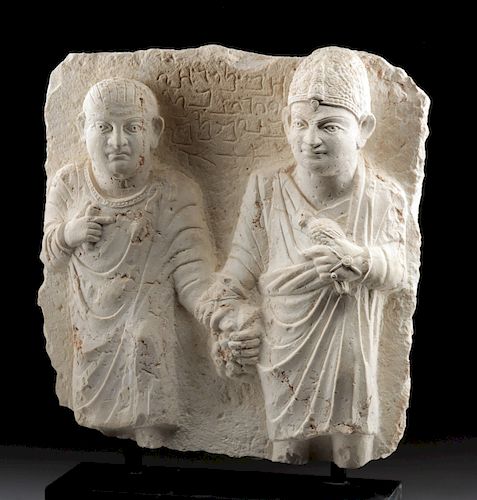Palmyra Limestone Relief w/ 2 Brothers - Ex Sotheby's
Lot 94a
About Seller
Artemis Gallery
686 S Taylor Ave, Ste 106
Louisville, CO 80027
United States
Selling antiquities, ancient and ethnographic art online since 1993, Artemis Gallery specializes in Classical Antiquities (Egyptian, Greek, Roman, Near Eastern), Asian, Pre-Columbian, African / Tribal / Oceanographic art. Our extensive inventory includes pottery, stone, metal, wood, glass and textil...Read more
Estimate:
$9,000 - $12,000
Absentee vs Live bid
Two ways to bid:
- Leave a max absentee bid and the platform will bid on your behalf up to your maximum bid during the live auction.
- Bid live during the auction and your bids will be submitted real-time to the auctioneer.
Bid Increments
| Price | Bid Increment |
|---|---|
| $0 | $25 |
| $300 | $50 |
| $1,000 | $100 |
| $2,000 | $250 |
| $5,000 | $500 |
| $10,000 | $1,000 |
| $20,000 | $2,500 |
| $50,000 | $5,000 |
| $100,000 | $10,000 |
| $200,000 | $20,000 |
About Auction
By Artemis Gallery
Sep 26, 2019
Set Reminder
2019-09-26 10:00:00
2019-09-26 10:00:00
America/New_York
Bidsquare
Bidsquare : Exceptional Day 1: Antiquities & Asian Art
https://www.bidsquare.com/auctions/artemis-gallery/exceptional-day-1-antiquities-asian-art-4437
Day 1 of an important 2-day auction featuring exceptional, museum-worthy examples of Egyptian, Greek, Etruscan, Roman, Viking, Russian, Near Eastern, as well as Asian Art from China, Japan, Thailand, Vietnam, Burma and India. Artemis Gallery info@artemisgallery.com
Day 1 of an important 2-day auction featuring exceptional, museum-worthy examples of Egyptian, Greek, Etruscan, Roman, Viking, Russian, Near Eastern, as well as Asian Art from China, Japan, Thailand, Vietnam, Burma and India. Artemis Gallery info@artemisgallery.com
- Lot Description
Near East/Holy Land, Palmyra, Roman period, ca. 2nd century CE. Finely carved in high relief, two brothers, standing and appearing to advance toward the viewer given their slightly bent left knees. Perhaps they are about to attend a banquet, as one brother is holding a cluster of grapes and the other is holding a pheasant or another game bird close to his chest. Both figures are draped in voluminous garments with folds of drapery billowing over their forms. The brother holding the bird also wears a conical cap with a pendant over his forehead and a glove (perhaps a raptor glove) decorated with a large jewel, while the brother holding grapes wears a beaded collar on his himation. There is a Palmyrene inscription behind that translates, "Alas! Yarhai et Yaribola, sons of MLBA(?)" Size: 16.5" W x 18.5" H (41.9 cm x 47 cm); 21.875" H (55.6 cm) on included custom stand.
Palmyra was a wealthy city that linked the caravan routes from the Parthian Near East with the Roman Mediterranean; the people who lived there during this period largely enjoyed prosperity and were able to adopt eastern and western customs, clothing, and artistic styles, creating a distinctive visual culture unique to the city. We know of this culture today from the large funerary monuments that the Palmyrans built - tower-shaped vaults whose interiors were lined with sculpted limestone reliefs depicting the deceased. Many of these, as we see in this example, had inscriptions which gave the name and family history of the deceased.
Provenance: private J.H. collection, Beaverton, Oregon, USA; ex-Sotheby's New York, June 2011; ex-private collection, early 1970's
All items legal to buy/sell under U.S. Statute covering cultural patrimony Code 2600, CHAPTER 14, and are guaranteed to be as described or your money back.
A Certificate of Authenticity will accompany all winning bids.
We ship worldwide and handle all shipping in-house for your convenience.
#149583Losses to peripheries and high-pointed areas as shown. Figures' legs are missing. Front section of father and head of son reattached. Normal surface wear with areas of encrustation.Condition
- Shipping Info
-
All shipping is handled in-house for your convenience. Your invoice from Artemis Gallery will include shipping calculation instructions. If in doubt, please inquire BEFORE bidding for estimated shipping costs for individual items.
-
- Buyer's Premium



 EUR
EUR CAD
CAD AUD
AUD GBP
GBP MXN
MXN HKD
HKD CNY
CNY MYR
MYR SEK
SEK SGD
SGD CHF
CHF THB
THB














